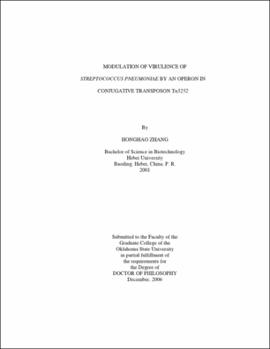| dc.contributor.advisor | Vijayakumar, Moses | |
| dc.contributor.author | Zhang, Honghao | |
| dc.date.accessioned | 2013-11-26T08:23:01Z | |
| dc.date.available | 2013-11-26T08:23:01Z | |
| dc.date.issued | 2006-12 | |
| dc.identifier.uri | https://hdl.handle.net/11244/6688 | |
| dc.description.abstract | Scope and Method of Study: The aim of this work was to study of the function of the 7.4 kb DNA in the central region of Tn5252. Through virulence assay, we would determine if this operon is involved in the pathogenesis of S. pneumoniae. Furthermore, if this operon was involved in pathogenesis, we would carry out experiments to determine how this operon is involved in the pathogenesis of S. pneumoniae. | |
| dc.description.abstract | Findings and Conclusions: The streptococcal mobile element, Tn5252 (47 kb), carries an 8 kb operon containing four genes the largest of which is about 6 kb and highly homologous to eukaryotic SNF2-like DNA methyl transferase/helicases that are involved in gene regulation. The helicase operon was introduced into the chromosome of clinical pneumococcal strains by additive transformation. When introduced intraperitoneally into young female BALB/c mice, strains bearing the intact helicase operon were found to be significantly less pathogenic than the parental wild type strain or the one with the mutated operon. However, when introduced into the nasopharyngeal region, cells carrying the intact helicase operon were able to cause significantly more death than the other two. In competition experiments, the cells carrying the helicase operon were much more successful than others in colonization of the nasopharyngeal niche while no differences in growth patterns between the two were found when cocultured in vitro. In vitro the expression of the helicase operon was not constitutive. Following placement of the inducible pneumococcal malX promoter upstream of the operon, it was observed that activation of the operon by maltose renders the cells more susceptible to oxidative damage by hydrogen peroxide Also it was observed that activation of the operon lead to induced expression of spxB, and increased autolysis. Taken together with the results virulence assay, it is suggested that activation of the helicase operon would have an effect on pneumococcal phase variation. | |
| dc.format | application/pdf | |
| dc.language | en_US | |
| dc.rights | Copyright is held by the author who has granted the Oklahoma State University Library the non-exclusive right to share this material in its institutional repository. Contact Digital Library Services at lib-dls@okstate.edu or 405-744-9161 for the permission policy on the use, reproduction or distribution of this material. | |
| dc.title | Modulation of virulence of Streptococcus pneumoniae by an operon in conjugative transposon Tn5252 | |
| dc.contributor.committeeMember | Burnham, Kim | |
| dc.contributor.committeeMember | Hadweiger, Jeffery | |
| dc.contributor.committeeMember | Sukhan, Anand | |
| dc.contributor.committeeMember | Eberle, Richard | |
| osu.filename | Zhang_okstate_0664D_2057.pdf | |
| osu.accesstype | Open Access | |
| dc.type.genre | Dissertation | |
| dc.type.material | Text | |
| thesis.degree.discipline | Microbiology | |
| thesis.degree.grantor | Oklahoma State University | |
